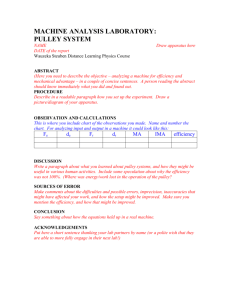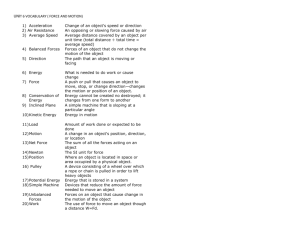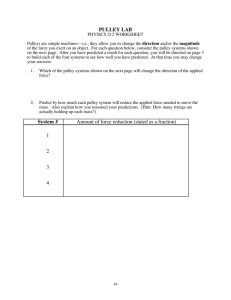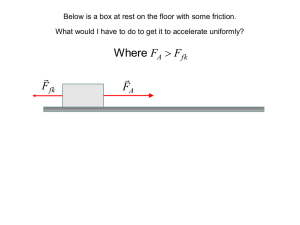Newton`s Second Law for Rotation
advertisement
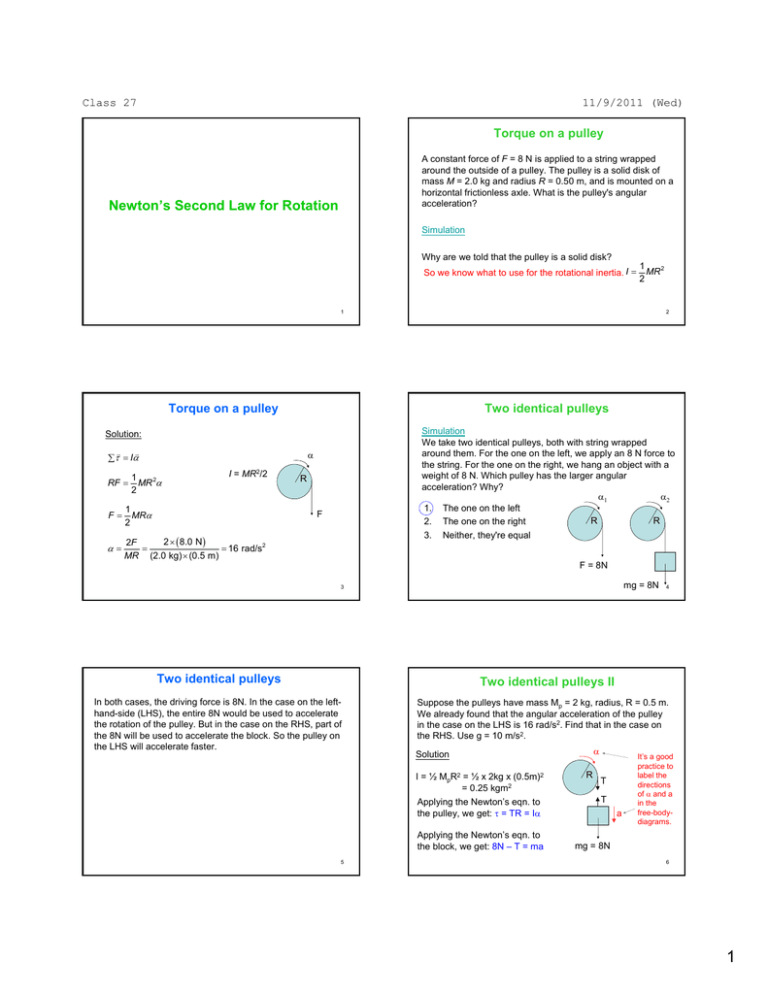
Class 27 11/9/2011 (Wed) Torque on a pulley A constant force of F = 8 N is applied to a string wrapped around the outside of a pulley. The pulley is a solid disk of mass M = 2.0 kg and radius R = 0.50 m, and is mounted on a horizontal frictionless axle. What is the pulley's angular acceleration? Newton’s Second Law for Rotation Simulation Why are we told that the pulley is a solid disk? So we know what to use for the rotational inertia. I = 1 MR 2 2 1 2 Torque on a pulley Two identical pulleys Simulation We take two identical pulleys, both with string wrapped around them. For the one on the left, we apply an 8 N force to the string. For the one on the right, we hang an object with a weight of 8 N. Which pulley has the larger angular acceleration? Why? α1 α2 1. The one on the left R R 2. The one on the right Solution: v v ∑ τ = Iα RF = α 1 MR 2α 2 I= MR2/2 F= 1 MRα 2 α= 2 × ( 8.0 N) 2F = = 16 rad/s2 MR (2.0 kg) × (0.5 m) R F 3. Neither, they're equal F = 8N mg = 8N 3 Two identical pulleys 4 Two identical pulleys II In both cases, the driving force is 8N. In the case on the lefthand-side (LHS), the entire 8N would be used to accelerate the rotation of the pulley. But in the case on the RHS, part of the 8N will be used to accelerate the block. So the pulley on the LHS will accelerate faster. Suppose the pulleys have mass Mp = 2 kg, radius, R = 0.5 m. We already found that the angular acceleration of the pulley in the case on the LHS is 16 rad/s2. Find that in the case on the RHS. Use g = 10 m/s2. α Solution I = ½ Mp R2 = ½ x 2kg x = 0.25 kgm2 (0.5m)2 Applying the Newton’s eqn. to the pulley, we get: τ = TR = Iα Applying the Newton’s eqn. to the block, we get: 8N – T = ma 5 R T T a It’s a good practice to label the directions of α and a in the free-bodydiagrams. mg = 8N 6 1 Two identical pulleys II In the above two equations, there are three unknowns, namely T, α and a. With that, we need three equations to solve for their values. The third equation comes from the fact that the pulley and the block are connected by the string that wraps around the outer rim of the pulley. With that, a = Rα. Two identical pulleys II α R T T a It’s a good practice to label the directions of α and a in the free-bodydiagrams. mg = 8N α From the above discussions, we have the three equations: R TR = Iα = ½ MpR2α …….…...(1) 8N – T = ma …………(2) a = Rα ……………….(3) Substitute (3) in (2), 8N – T = mRα ……………….(4) T T It’s a good practice to label the directions of α and a in the a free-bodydiagrams. mg = 8N Eq. (1) ⇒ T = ½ MpRα …….…...(1’) (4) + (1’) ⇒ 8N = (½ Mp+m)Rα ⇒ α = 8N / [(1/2 x 2kg + 0.8kg) x 0.5m)] = 8.89 rad/s2. 7 Atwood’s machine 8 Re-analyzing the Atwood’s machine Atwood’s machine involves one pulley, and two objects connected by a string that passes over the pulley. In general, the two objects have different masses. a This is less than that in case 1 as we predicted. When we analyzed Atwood’s machine in the past, we neglected the mass of the pulley (i.e., we assumed that the pulley is massless). If we include the mass of the pulley, we should expect the acceleration of the masses m and M to be: a 1. larger than before. 2. smaller than before. 3. the same as before. 9 10 Acceleration in an Atwood’s machine II Re-analyzing the Atwood’s machine Problem: Find an expression for the acceleration of m and M in an Atwood’s machine with a pulley mass of mp. In an Atwood’s machine, the driving force is (M – m)g. When the pulley is not massless, part of the driving force is diverted into accelerating the pulley’s rotation. Solution: The pulley can be considered a solid disc, with I = ½ mpR2, where R is the radius of the pulley. Physical picture: In the Atwood’s machine, the tension force pulling on the heavier mass M is larger than that pulling on the lighter mass m. This results in a net clockwise torque and hence a clockwise angular acceleration in the pulley. 11 12 2 Acceleration in an Atwood’s machine II Acceleration in an Atwood’s machine II Step 2: Analyze the heavier block Step 1: Analyze the lighter block Sketch the free-body diagram for the lighter block. Choose a positive direction, and apply Newton’s Second Law. Sketch a free-body diagram for the heavier object. Choose a positive direction, and apply Newton’s Second Law. Choose positive down this time, to match the object’s acceleration. Let’s choose positive to be up, i.e., in the direction of the acceleration. FT2 FT1 FT1 FT1 v v ∑ F = ma FT2 v v ∑ F = Ma a a FT2 +Mg − FT 2 = +Ma +FT 1 − mg = +ma mg Mg 13 Acceleration in an Atwood’s machine II 14 Acceleration in an Atwood’s machine II Step 3: Analyze the pulley Step 4: combine the equations Sketch a free-body diagram for the pulley. Choose a positive direction, and apply Newton’s Second Law for rotation. Choose positive clockwise, to match the pulley’s angular acceleration. v v ∑ τ = Iα α ⎛1 ⎞ +RFT 2 − RFT 1 = + ⎜ mpR 2 ⎟ α I = ½mpR2 ⎝2 ⎠ FT1 equal FT2 ⎛1 ⎞a +FT 2 − FT 1 = + ⎜ mpR ⎟ ⎝2 ⎠R 1 +FT 2 − FT 1 = + mpa 2 (Note that R cancels out so it is not needed to be specified.) 15 Lighter block: +FT 1 − mg = + ma Heavier block: +Mg − FT 2 = +Ma Pulley: 1 +FT 2 − FT 1 = + mpa 2 Add the equations: +Mg − mg = +Ma + ma + Previous result for massless pulley Mg − mg a= M +m 1 mp a 2 1 ⎛ ⎞ +Mg − mg = ⎜ M + m + mp ⎟ a 2 ⎝ ⎠ a= Mg − mg m M +m+ p 2 16 The end 17 3

